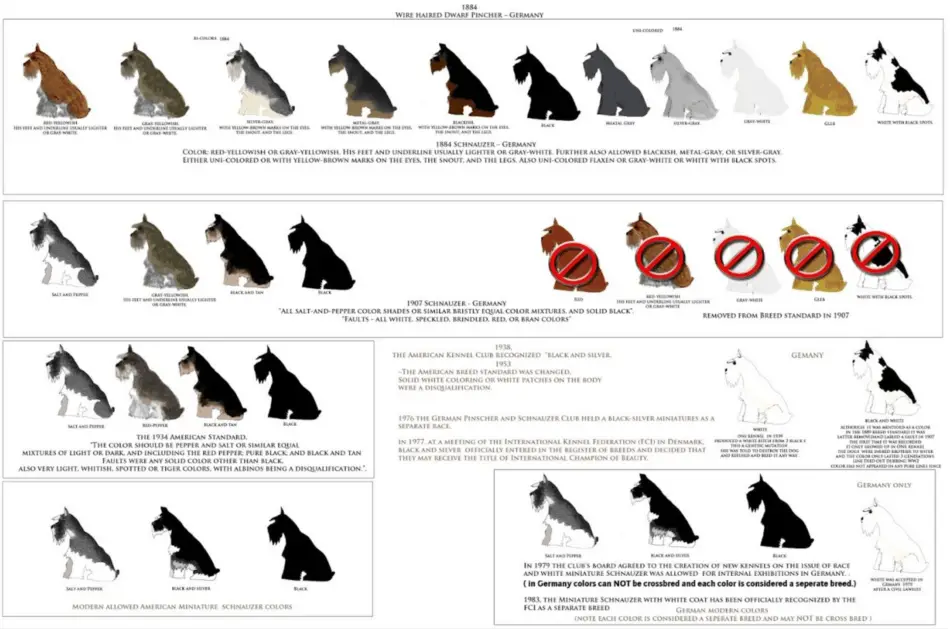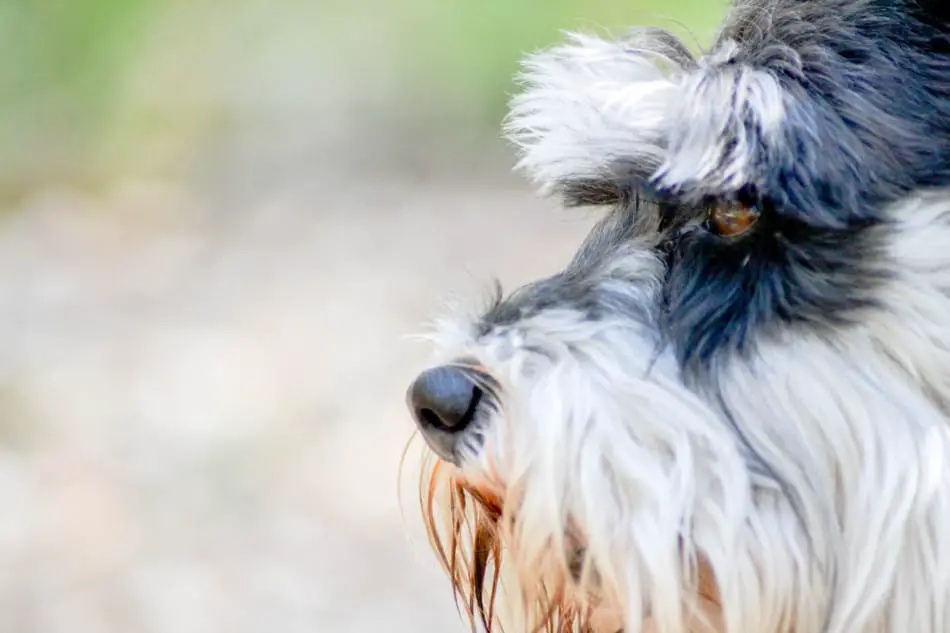When we picked up Livi from the breeder, she was a lively, beautiful little thing in a wiry black bundle of hair. We were getting used to the demands of taking good care of her coat and beard, and at one point during that first summer we decided to have the groomer shave her coat. Suddenly, her black and wiry outer coat was gone, giving way to a beautiful, shimmery sliver undercoat. While it’s not the traditional way to groom a Schnauzer, clipping the outer coat is becoming more accepted and popular. For us, it was the right decision. However, because it also revealed such a dramatic change in Livi’s color and appearance, I wondered what other types of situations might affect the color of a Schnauzer’s coat. Here’s what I found.
Why do Schnauzers change color? A Schnauzer’s coat can change color over time due to clipping, aging, health and diet, hair loss and regrowth, and genetics. Their coats can also fade as they age. In addition, dark black or white coats may change more noticeably over time.
While genetics explain the better part of the color equation, other the factors such as age, clipping, diet, and health can cause your Schnauzer to change color over time. Some of the color change is beyond your control, but keeping your Schnauzer healthy and feeding him high-quality dog food or even making his food yourself, will help to keep his coat healthy and stabilized.
Let’s start with the most common Schnauzer color combinations, and then dive into why you might be noticing a change (and when to call the veterinarian for help).
Schnauzer Color Options
Schnauzers are bred specifically to result in a variety of accepted breed colors, as well as for newer “designer” options.
According to American Kennel Club, black, gray, silver, salt and pepper are the recognized Schnauzer colors. However, modern colors also include pure white, parti-colored, and chocolate. Schnauzers that have been bred white or other patterns are considered non-standard in the USA.
You can select a breed that specializes in traditional colors or one that creates designer combinations. If you are simply looking for a unique Schnauzer look and color, designer options have added some interesting variety to the entire breed.
However, if you are interested in breeding your Schnauzer or in training him as a show dog, you will need to select a traditional color, a highly reputable breeder known for excellent pedigrees, and a puppy with all of the credentials.
Having said that, all Schnauzers breeders should only be breeding for improvement, health, and longevity of the breed.
Depending on which breed you have, you will be interested in our breed guides available on our Start Here page.
This graphic gives you an overview of the possible breed-standard colors along with the history of acceptance. Clicking the image will display a much larger view for reading or printing. The graphic is courtesy of https://socalminischnauzers.com/.

This graphic displays the variety of normal (not designer) Schnauzer colors, but as your Schnauzer ages, you will become the expert yourself and be able to detect changes in his color. Many of the changes you notice will be a normal part of his growth and aging.
However, there is also the possibility that color changes can be a signal of health problems or a poor diet.
Let’s talk about when color changes might occur and what can cause a change in your Schnauzer’s coat.
When Should You Expect A Color Change in Your Schnauzer?
Over the course of your Schnauzer’s life, he will possibly experience normal, safe changes in his coat’s coloration. Most changes will simply be due to his stage in life, so it’s important to know the times when you might see natural, harmless transitions.
Puppyhood to Adulthood
Schnauzers are born with different colors and markings. However, some may experience a change in color from as early as a few weeks while some as late as 8 to 10 years. You can expect your Schnauzer to possibly undergo a color change starting from a few weeks after birth up to adulthood.
Small dogs reach maturity early, and Miniature Schnauzers are no exception. Therefore, you can expect to see color change early if your puppy matures fast. Male Miniatures become sexually mature between 5 to 6 months, while the females become sexually mature by approximately 7 months.
Standard and Giant Schnauzers will generally mature more slowly.
Seniorhood
In senior dogs, the fur fades as a result of loss in pigmentation. Pigment consumes energy, so as your Schnauzer ages and reaches senior status, his body focuses most energy toward other vital functions.
Lifetime Fading
Simple fading is the most noticeable color change in Schnauzers. While some fade slowly, others fade more dramatically. For instance, puppies with salt & pepper coloring tend to get lighter as they mature, ultimately reaching a light grey color. Similarly, black and silver puppies have prominent markings at birth, but as they mature the black and silver tend to fade to dark grey. White Miniature Schnauzers tend to maintain their color throughout their life.
5 Reasons Schnauzers Change Color
Over his lifetime, an average Schnauzer will either become lighter or darker. But what are the possible causes of change in the color of his coat?

There are essentially 5 reasons your Schnauzer might undergo a change in coat color.
#1 Natural Changes with Aging
Even though we’ve just covered stages of life that may result in coloration changes, It’s okay to remind you here that most changes over time are normal. The changes will usually be gradual and harmless. However, if you notice color changes that seem to be abrupt, check with your veterinarian.
#2 Clipping
Clipping and repeated shaving of your schnauzer can lead to color change. Clipping or close shaving can damage hair follicles and potentially lead to color change. In addition, clipper burns can cause inflammation that triggers the body to send melanin cells to the injured part, resulting in dark skin and hair. It’s probably not a major cause, but you should be aware that shaving can result in changes to your Schnauzer’s coat.
The most common reason for clipping being the “cause” of your Schnauzer’s new color is simply because it exposes the undercoat. This is the very thing we experienced with Livi. When you clip a Schnauzer, his undercoat is exposed and it will most likely vary from black to silver.
#3 Skin Issues and Hair Loss
If your Schnauzer has allergies or has even been sunburned, the itching and overall damage can result in patches of hair loss.
Some Schnauzer owners have observed that when the hair grows back, it’s a different color that the rest of his coat. Sometime the regrowth even resembles the coat color he had as a puppy. Sometimes, however, regrowth takes a long time or never fully recovers. Healthy changes in diet (covered next) can possibly help.
You will also want to read my articles Do Schnauzers Have Allergies? (Causes, Symptoms, and Treatments) and Can Schnauzers Hack the Hot Weather? (How to Help) for essential details that can give you essential information and resources.
#4 Diet
The type of food you feed your Schnauzer can affects the color of his coat.
If you are feeding your Schnauzer dry dog food, even the artificial dyes can stain his beard and ultimately affect his health and coat.
It’s always wise to select high-quality dog food with natural ingredients, or simply make his food or treats yourself. There are even excellent meal delivery options. I have incorporated all of these options into Livi’s diet since, especially as a senior, she is increasingly at risk for any number of issues.
#5 Health Issues (and When to Call Your Veterinarian)
There are some diseases such as Hypothyroidism that affect thyroid and leads to a change in coat color. This disease mostly affects middle-aged medium and large dogs such as Standard and Giant Schnauzers.
In addition, your Schnauzer’s tear and saliva contain contains porphyrins, which stains fur and causes a color change. Porphyrins are excreted primarily through bile and the intestinal tract, but your Schnauzer will also eliminate a large proportion through his tears, saliva, and urine. While porphyrin staining itself is a harmless cosmetic issue, it can also be an indicator of an underlying health problem such as eye problems or allergies.
And most worrisome, mouth, eye, and coat stain can be an indication of periodontal disease, inflammation, infection, conformational abnormalities, or even cancer.
When to Call Your Veterinarian
If you are noticing chronic staining or any discoloration that seems abnormal, please call your veterinarian for assistance. You will want to document how long you’ve noticed color changes and keep track, if possible, of any changes to his diet or health. Your veterinarian will mostly like perform a complete check-up and order labs, if necessary.
Far from being purely cosmetic, it is important to pay attention to your Schnauzer’s appearance, and changes in color should be part of your ongoing observations. While most color change is normal and even expected, knowing the signs of something more serious is just being a great pet parent.
And finally, from one pet parent to another, discover my all-time favorite resources designed to cover your every Schnauzer need. I’ve done the legwork for you so you can spend more time with the people and fur friends in your life.
A portion of all profit earned on this site is donated to Pet Partners
whose mission is to improve human health and
well-being through the human-animal bond.
They train and register pets to become therapy animals,
and have local chapters in many states.

